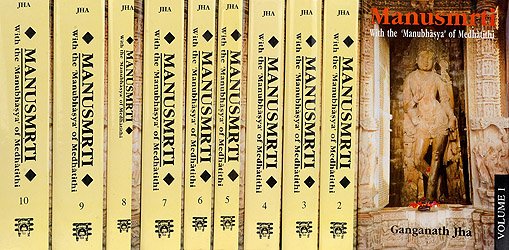Manusmriti with the Commentary of Medhatithi
by Ganganatha Jha | 1920 | 1,381,940 words | ISBN-10: 8120811550 | ISBN-13: 9788120811553
This is the English translation of the Manusmriti, which is a collection of Sanskrit verses dealing with ‘Dharma’, a collective name for human purpose, their duties and the law. Various topics will be dealt with, but this volume of the series includes 12 discourses (adhyaya). The commentary on this text by Medhatithi elaborately explains various t...
Verse 5.16
Sanskrit text, Unicode transliteration and English translation by Ganganath Jha:
पाठीनरोहितावाद्यौ नियुक्तौ हव्यकव्ययोः ।
राजीवान् सिंहतुण्डाश्च सशल्काश्चैव सर्वशः ॥ १६ ॥pāṭhīnarohitāvādyau niyuktau havyakavyayoḥ |
rājīvān siṃhatuṇḍāśca saśalkāścaiva sarvaśaḥ || 16 ||The ‘Pāṭhīna’ and the ‘Rohita’ are fit to be eaten when used as offerings to gods or Pitṛs; the ‘Rājīva’, the ‘Siṃhatuṇḍa’ and the ‘Saśalka,’ (one may eaṭ) on all occasions—(16)
Medhātithi’s commentary (manubhāṣya):
‘Pāṭhīna’ and ‘Rohita’—two particulars kinds of fish-having been mentioned as fit to be offered to Gods and to Pitṛs, the eating of these is permitted on the occasion of the performance of Śrāddha and other rites; and not in the course of ordinary daily food. As for the Rājīva, the ‘Siṃhatuṇḍa’ and the ‘Saśalka’ fish on the other hand, these are to be eaten ‘on all occasions’; i.e. they may be eaten also on occasions other than the offerings to Gods and to Pitṛs.
‘Rājīva’ some people regard this as standing for lotus-coloured fish. Others explain it as standing for those fish that are marked by lines.
‘Siṃhatuṇḍa,’—those having a lion-like face.
‘Saśalka’—is the same as the fish called ‘Shakalin.’—(16).
Explanatory notes by Ganganath Jha
Medhātithi and Govindarāja explain the meaning to be that “The Pāṭhīna and the Rohita are to be eaten only when offered to the gods or Pitṛs, and not ordinarily, while those enumerated in the second half are to be eaten ‘sarvasaḥ’ at all times.”—Kullūka objects to this explanation on the following grounds:—There is no authority for the view that the two kinds of fish are to be offered at Śrāddhas, eaten only by the person invited at it, not by the performer of the Śrāddha or other persons, while the other kinds are to be eaten by others also;—in fact all other authorities have placed all those mentioned here on the same footing. Kullūka’s own explanation is as follows:—‘The Pāṭhīna and the Rohita should be eaten, as also the Rājīva and the rest’;—and the phrase ‘niyuktau havyakavyoḥ’ he takes as standing by itself, in the sense that ‘all things that are forbidden may be eaten, when one is threatened with starvation, after they have been offered to the gods and Pitṛs.’
This verse is quoted in Mitākṣarā (on 1.178), which goes one farther than Medhātithi, and adds that those enumerated in the second line also are to be eaten only when offered at Śrāddhas and sacrifices;—and in Vīramitrodaya (Āhnika, p. 547), which adds the following notes:—‘ādyau’ means ‘are to be eaten’—when they are ‘niyuktau’—i.e., used for the purpose of Śrāddha and other offerings;—‘Pāṭhīna’ is that which is also called ‘Chandraka,’ ‘Rājīva’ is red-coloured, ‘Siṃhatuṇḍa,’ is that which has its mouth like the lion’s, ‘Saśalka’ are fish covered with shell-like skin.
It is quoted in Smṛtattva (p. 449);—in Hemādri (Śrāddha, p. 577);—and in Smṛtisāroddhāra (p. 300), which explains ‘niyuktau,’ as employed for Śrāddha and other purposes, and ‘ādyau’ as ‘may be eaten,’ ‘rājīva’ as red-coloured.
Comparative notes by various authors
(verses 5.15-16)
See Comparative notes for Verse 5.15.
